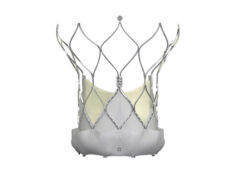
The first randomised controlled trial to compare percutaneous edge-to-edge repair (MitraClip, Abbott) with medical therapy alone in patients with secondary mitral regurgitation (to heart failure) has shown no evidence that the percutaneous device provides benefit in terms of prognosis. These findings indicate that regurgitation may be a marker of worse prognosis in heart failure than a cause of worse prognosis.
Study investigator Jean-Francois Obadia (Hôpital Cardiovasculaire, Louis Pradel, Chirurgie Cardio-Vasculaire et Transplantation Cardiaque, Lyon, France), speaking in a Hot Line session at the 2018 European Society of Cardiology (ESC) Congress (25-29 August, Munich, Germany), said it was “well established” that there was “a strong correlation between mitral regurgitation severity and prognosis”. He added that while this had led to therapies (both surgical and percutaneous) that aimed to reduce regurgitation, there was no evidence that reducing regurgitation would improve prognosis.
According to Obadia, both European and US guidelines recognise the lack of data in this area and have called for randomised controlled trials. Therefore, the aim of MITRA-FR (Percutaneous repair with the MitraClip for severe functional/secondary mitral regurgitation) was to address this issue and evaluate the safety and efficacy of the MitraClip procedure in a randomised setting. In the study,
307 patients with secondary mitral regurgitation were randomised to receive a MitraClip device (152) or to receive medical therapy alone (152 after three patients were excluded because of problems with obtaining informed consent). The primary endpoint was a composite of all-cause mortality and unplanned hospitalisation for heart failure at 12 months and secondary endpoints included the individual components of the primary endpoint, death from cardiovascular causes, and survival from major adverse cardiovascular events.
In an intention-to-treat analysis, the rate of the primary endpoint was 54.6% for the MitraClip group and 51.1% for the control group; a non-significant difference (p=0.53). The rates of the individual components of the primary endpoint—all-cause mortality (24.3% and 22.4%, respectively) and unplanned hospitalisation for heart failure (48.7% vs. 47.4%, respectively)—were similar between groups as were the rates for the other secondary endpoints (cardiovascular death and MACE). A per-protocol analysis, which excluded 14 patients in the interventional group who did not ultimately receive the device, was performed and its results were consistent with the findings of the intention-to-treat analysis.
Obadia said: “We found absolutely no difference in terms of the primary endpoint of all-cause mortality and unplanned hospitalisation; there was not even a trend towards a difference. We performed a subgroup analysis to see if there would be trend somewhere but there was not. Not even when we analysed the results according to severity of regurgitation.” However, he noted that the study was not powered to detect smaller differences between subgroups (MITRA-FR was only powered to detect a substantial effect in the primary outcome). “Although our overall findings are very strong, we have to be careful about making conclusions about the efficacy of the device for subgroups as they were small. Potentially, future studies could explore the efficacy of MitraClip in selected patients,” he added.
MITRA-FR did confirm the findings of previous registries that percutaneous edge-to-edge repair was both a safe procedure and an effective approach for reducing regurgitation; in the interventional group, 76.4% of patients had mitral regurgitation of grade 0+ to 1+ at the time of hospital discharge (all patients had severe regurgitation at baseline).
Concluding his presentation at the ESC Congress, Obadia said that MITRA-FR was designed to answer two key questions: whether MitraClip was safe and whether it was effective in terms improving prognosis. “It was very important that we had a control group as thanks to this control group, we have answered the question about whether the use of MitraClip alters prognosis. The answer is no. The main cause of worse prognosis in heart failure is probably the underlying pathology and probably mitral regurgitation is more of a marker of worse prognosis than a cause.”
Windecker, acting as the ESC Congress discussant for MITRA-FR, said: “To put these findings in context, the MITRA-FR patients were the sickest patients that have been investigated and reported so far. It is notable that both in terms of mortality and unplanned hospitalisation, the event rates were higher than those reported in a registry—usually the reverse is true.” He added that, as the device was shown to be safe and reduce mitral regurgitation, “heart teams are entitled to consider using MitraClip as palliative therapy in selected patients who remain highly symptomatic despite medical therapy.”
Coinciding with the presentation at the ESC Congress, the study was simultaneously published in The New England Journal of Medicine.










